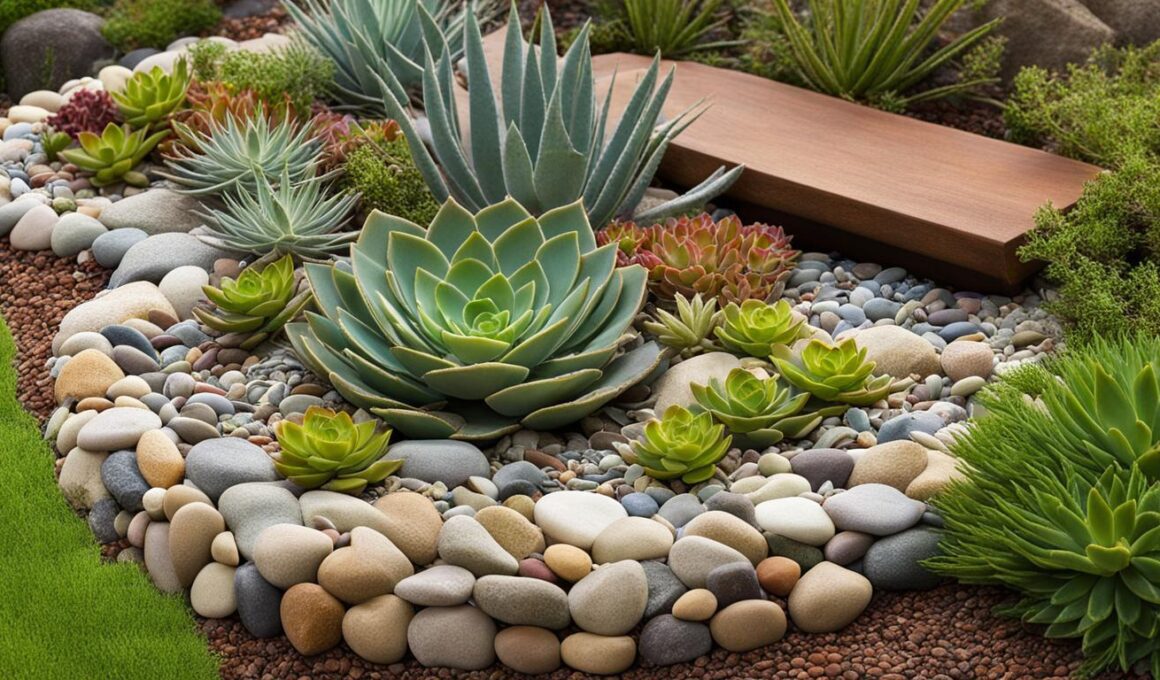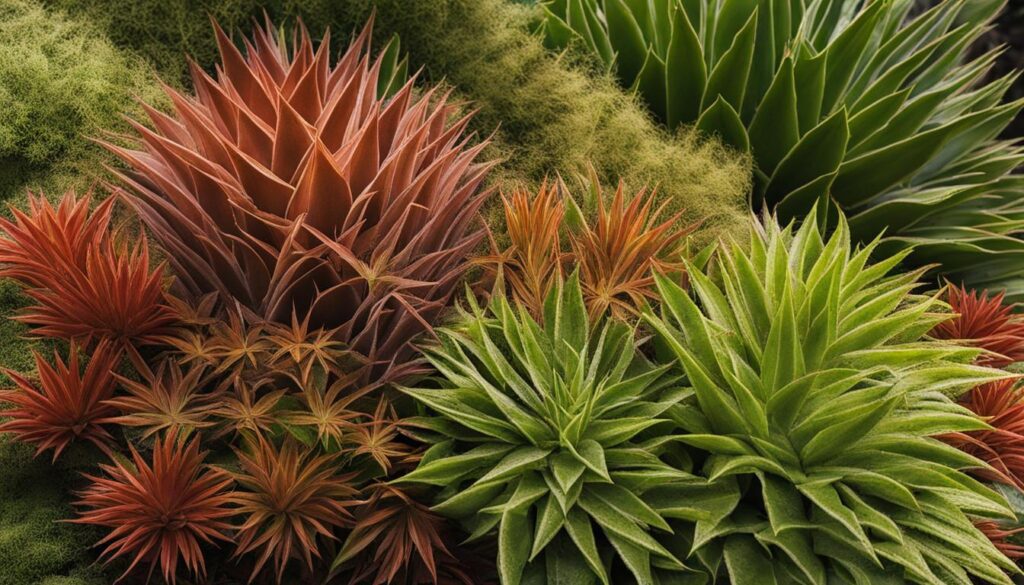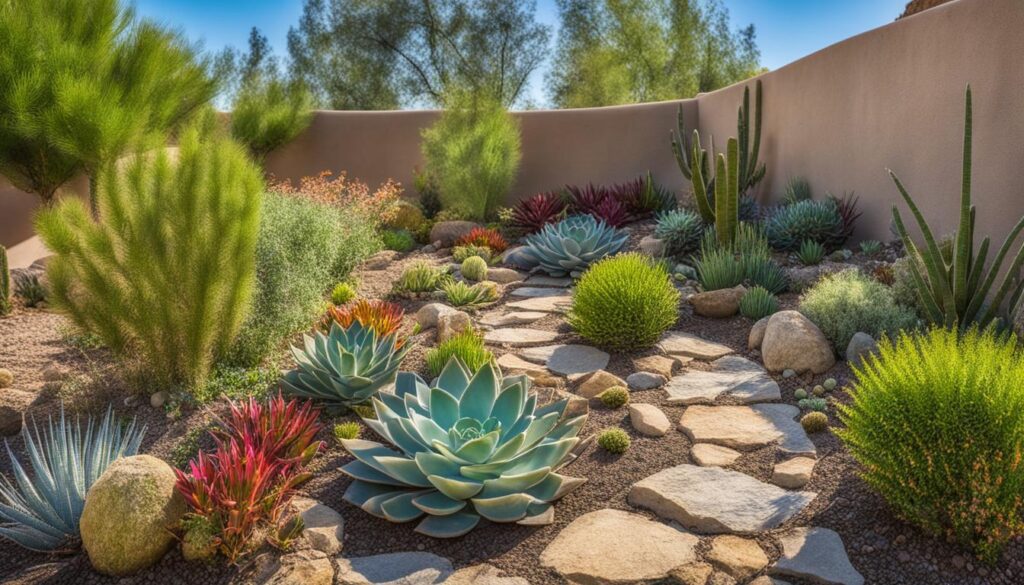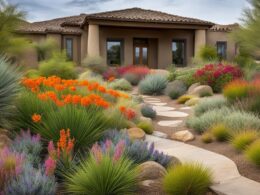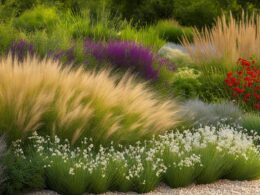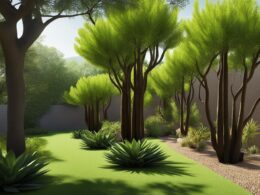Looking to transform your small outdoor space into a water-efficient landscape that requires minimal maintenance? Xeriscaping is the answer! This innovative gardening technique focuses on conserving water and choosing drought-tolerant plants to create stunning, low-maintenance gardens that make a big impact. Whether you have a tiny backyard or a small balcony, xeriscaping can help you maximize your space while minimizing water usage. Here are some valuable tips to get you started on your xeriscaping journey.
Key Takeaways:
- Xeriscaping is a water-efficient landscaping technique suitable for small spaces.
- By grouping plants based on their water needs and choosing drought-tolerant varieties, you can create a low-maintenance and beautiful landscape.
- Xeriscaping promotes water conservation, reduces the use of chemicals and fertilizers, and saves money on irrigation and lawn maintenance.
- Proper planning, plant selection, and implementation of xeriscaping techniques are essential for success.
- Xeriscaping offers benefits such as low maintenance, cost savings, and a sustainable outdoor space.
Planning Your Xeriscape Garden
When embarking on the journey of creating a beautiful and water-wise xeriscape garden, careful planning is key. Instead of focusing solely on aesthetics, consider the topography, exposure, and soil of your garden. By taking advantage of the natural attributes of your site, you can create distinct planting zones based on the water needs of different plants. Group drought-tolerant plants in areas exposed to full-day sun, while providing partial shade for less tolerant plants. It’s also important to reserve a spot near your water source for more delicate or demanding plants.
Incorporating native plants in your xeriscape garden is highly beneficial. These plants are adapted to the local climate, making them naturally more water-efficient. The choice of plants will vary by region, so it’s important to research and select native species that thrive in your specific area. Even within a single town or street, different microclimates may exist, so it’s essential to consider the specific conditions of your garden when choosing plants.
“Planning is essential when creating a water-wise xeriscape garden.”
Selecting the Right Plants
When choosing plants for your xeriscape garden, opt for drought-tolerant varieties that can thrive in low water conditions. Drought-tolerant flowers and ground covers, such as penstemon, blanket flowers, and coreopsis, can add vibrant colors to your flower beds while conserving water. Incorporating drought-tolerant shrubs like butterfly bush, cotoneaster, and juniper can add structure and visual interest to your xeriscape design. When it comes to trees, consider options such as sunburst honey locust, which can provide shade and beauty without excessive water needs. Ornamental grasses like feather reed grass and fountain grass can add texture and movement to your xeriscape garden.
By planning your xeriscape garden carefully and selecting the right plants, you can create a visually appealing and water-wise landscape that thrives in limited spaces. In the next section, we will explore the implementation of xeriscaping techniques to ensure the most efficient use of water and resources in your garden.
Choosing the Right Plants for Xeriscaping
Xeriscaping doesn’t mean limiting yourself to desert plants like cacti and succulents. There are many attractive plants that are drought-tolerant and naturally conserve water, making them ideal for xeriscape gardens. When selecting plants for your xeriscape garden, consider choosing native plants and other drought-tolerant varieties that thrive in your region’s climate. Here are some options for different areas of your xeriscape garden:
Drought-Tolerant Flowers
- Penstemon
- Blanket Flowers
- Coreopsis
Drought-Tolerant Shrubs
- Butterfly Bush
- Cotoneaster
- Juniper
Trees for Xeriscaping
- Sunburst Honey Locust
Ornamental Grasses
- Feather Reed Grass
- Fountain Grass
By incorporating these plants into your xeriscape garden, you can add texture, color, and interest while conserving water. Remember to consider the water needs, sun exposure, and soil requirements of each plant to ensure their successful growth in your xeriscape garden.
Implementing Xeriscaping Techniques
To achieve successful xeriscaping, there are several techniques you can implement. These techniques will not only help conserve water but also contribute to the overall health and aesthetics of your xeriscape garden.
1. Water Conservation:
One of the primary goals of xeriscaping is water conservation. Implementing a drip irrigation system is an effective way to control when and how much water each plant receives. By directing water only to the plants that need it, you can minimize water waste and ensure that each plant gets the appropriate amount of moisture.
2. Soil Amendment:
Amending your soil with compost and organic matter is crucial for a water-wise garden. This improves water penetration and retention, allowing your plants to better utilize the available moisture. Additionally, amended soil provides essential nutrients to support healthy plant growth.
3. Mulching:
Mulch plays a vital role in a xeriscape garden. By applying a layer of organic mulch around your plants, you can moderate soil temperature, reduce erosion, suppress weeds, and gradually feed the soil as the mulch breaks down. This helps retain soil moisture and reduces the need for frequent watering.
4. Proper Watering:
Proper watering is key to the success of a xeriscape garden. Water your plants based on their individual needs, rather than following a fixed schedule. As plants establish a strong root system, you can gradually decrease the frequency and duration of watering. This encourages plants to develop deep and healthy root systems, making them more resilient to drought conditions.
5. Weeding and Pest Management:
Maintaining a weed-free garden is essential for water conservation. Weeds compete with your plants for water and nutrients, so regularly removing them helps your xeriscape plants thrive. Additionally, practicing effective pest management techniques will ensure that pests do not damage your plants, reducing the need for excessive watering or pesticide use.
By implementing these xeriscaping techniques, you can create a water-efficient and sustainable garden while minimizing water usage and maintaining the health and beauty of your landscape.
Can I Use Permaculture Techniques to Enhance Xeriscaping in a Small Space?
Yes, you can definitely use permaculture xeriscaping combined approaches to enhance a small space. By integrating permaculture principles into xeriscaping, you can create a sustainable and water-efficient landscape that also promotes biodiversity and natural ecosystems. This combination can be particularly beneficial for small urban or suburban spaces.
Designing Your Xeriscape Garden
In designing your xeriscape garden, there are several key considerations to keep in mind. By incorporating thoughtful design elements, you can create a visually appealing and water-efficient outdoor space. Here are some tips to help you design your xeriscape garden:
- Garden Design: Begin by considering the overall layout and design of your xeriscape garden. Think about the size and shape of your space, as well as any existing features such as trees or structures. Determine how you want to use the space and create designated areas for different activities or plant groupings.
- Plant Placement: When it comes to plant placement in your xeriscape garden, it’s important to consider the water needs of different plants. Group plants with similar water requirements together to ensure efficient water usage. Place plants that require more water closer to a water source, and those that can thrive with minimal watering further away.
- Turf Grass Reduction: Consider reducing or eliminating turf grass areas in your xeriscape garden. Turf grass typically requires a significant amount of water to keep it green and healthy. Instead, opt for low-water alternatives such as flower beds, hardscapes, or rock gardens. These options not only require less water but also contribute to the overall aesthetics of your garden.
- Hardscapes and Rock Gardens: Incorporating hardscapes and rock gardens into your xeriscape design can add visual interest and texture to your outdoor space. Consider using materials such as gravel, rocks, or pavers to create pathways, seating areas, or focal points. These elements require minimal water and maintenance, making them ideal for a xeriscape garden.
Expert Tip:
“When designing your xeriscape garden, think about the overall theme or style you want to achieve. Consider incorporating native plants and drought-tolerant varieties that are well-suited to your region’s climate. This will not only ensure their survival but also create a cohesive and harmonious garden design.” – Jane Smith, Landscape Designer
By following these design principles, you can create a beautiful and sustainable xeriscape garden that thrives in limited areas. Remember to consider both the aesthetics and functionality of your space, and make choices that align with your water-conservation goals. With careful planning and thoughtful plant placement, you can enjoy a vibrant and low-maintenance xeriscape garden that enhances the beauty of your home.
Conclusion
Xeriscaping offers numerous benefits for your outdoor space, including water conservation, low maintenance, and cost savings. By adopting xeriscape principles, you can create a beautiful and sustainable landscape while minimizing water usage and the need for fertilizers and pesticides.
One of the key advantages of xeriscaping is its focus on water conservation. By selecting drought-tolerant plants and implementing techniques like drip irrigation and proper watering, you can significantly reduce your water consumption. This not only helps preserve this precious resource but also benefits the environment by minimizing water waste.
Another major advantage of xeriscaping is the low maintenance it requires. With careful planning, plant selection, and grouping based on water needs, you can create a garden that is self-sufficient and requires minimal upkeep. This means less time spent on watering, pruning, and pest management, allowing you to enjoy your outdoor space without the constant maintenance demands.
Lastly, xeriscaping can lead to significant cost savings. By reducing your water usage and eliminating the need for costly lawn maintenance, you can lower your monthly water bills and save money in the long run. Additionally, the reduced need for fertilizers and pesticides means fewer expenses and a more eco-friendly approach to gardening.
Consider xeriscaping as a viable option for creating a stunning and water-efficient garden, especially in limited areas. By implementing xeriscape techniques, you can create a thriving and sustainable landscape that not only adds beauty and value to your property but also contributes to a greener future.





